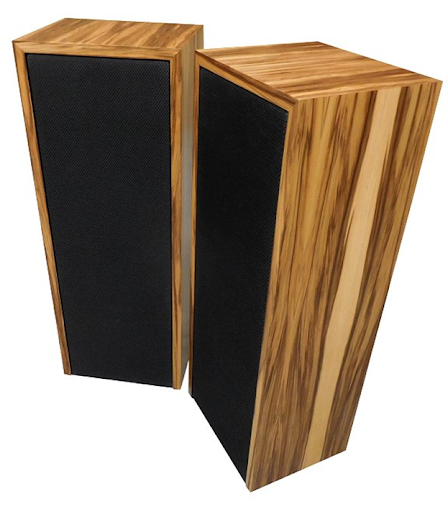
It took a while for me to get these speakers shipped to my house and set up in my listening room, but it was worth the wait. I first heard about them when I made my usual stop by the Volti/Border Patrol/Triode Wire Labs room at the 2020 Florida Audio Expo. I always make it a point to stop in to hear the consistently good sound they produce at every show.
Volti Audio was showing their new Rival SE speakers, and I was captivated by the sound in that room. In fact, this room was one of my top picks for Best of Show. While chatting with Greg Roberts, Volti Audio’s owner and designer, he mentioned a new speaker called the Razz that he was in the process of developing. Of course, I asked to be put on the list to review it when it was finished.
Greg Roberts is the kind of person I think we need more of in our industry. He doesn’t take himself too seriously, and he has fun with audio. You can quickly tell there is nothing pretentious about this guy. The speakers that he crafts are a labor of love that melds his excellent woodworking craftsmanship and his love for music together in one product. Do yourself a favor and make your way over to Volti Audio’s website, and be sure to dig into his newsletter section as they are quite entertaining and educational.
I Actually Had Fun!
I wrote an article earlier this year that asked if you are listening to your equipment or are you listening to the music. Most of the time, as a reviewer, I am listening to the equipment. That’s the job. But, Volti Audio’s Razz speakers simply would not allow that. As I tried to dissect the speaker, I repeatedly put my voice recorder down to just listen.
The Volti Audio Razz speakers drew me into familiar recordings in a way that was different from past listening sessions, but I am getting ahead of myself. Let’s cover the basics.
About the Volti Audio Razz v2s
The Razz is Volti Audio’s new entry-level speaker, ranging in price from $5,999 to $6,900 depending on finish choices. Other Volti Audio speakers include the three different models of the Rival lineup, ranging in price from $11,000 to $18,500, and the flagship all-horn Vittora speaker system at $30,000.
The Razz uses a 12-inch high-power, high-sensitivity woofer in a bass-reflex design that is front ported. The midrange incorporates a 2-inch compression driver with a composite diaphragm in the throat of a large damped metal horn that is described as a shallow wide dispersion design. The tweeter is a Neodymium Horn construction.
Razz speakers measure in at 40 inches tall, 15 inches wide and 12 inches deep. As shown above, the Razz v.2 speaker cabinet is constructed entirely out of CNC machined one-inch thick Baltic Birch plywood bonded together with polyurethane based adhesives. Each speaker weighs in at a substantial 90 lbs. Its sensitivity rating of 97dB puts it squarely in the high-efficiency category.
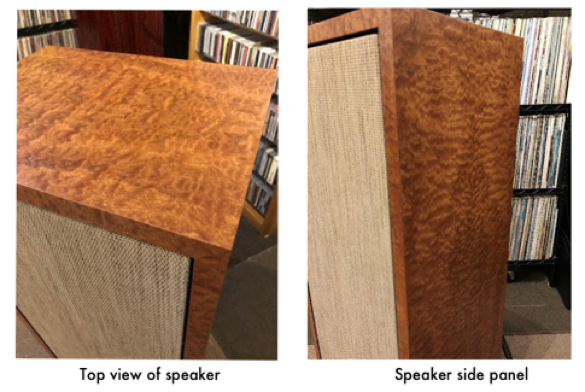
My review pair (shown above) had the upcharge Bosse Cedar veneer with magnetically attached grills wrapped in Tan Mix Weave fabric. I took a few pictures, but no picture is going to capture the beauty of this finish. Standard finishes are Walnut, Cherry, Ash, and Mahogany. Premium finishes offered at a $1,000.00 upcharge are Bosse Cedar, Rosewood, Red Gum, or Blacked Ash which is a dyed wood process and not just painted black. Suffice it to say that the speaker construction and woodworking are at a very high level not typically found at this price point.
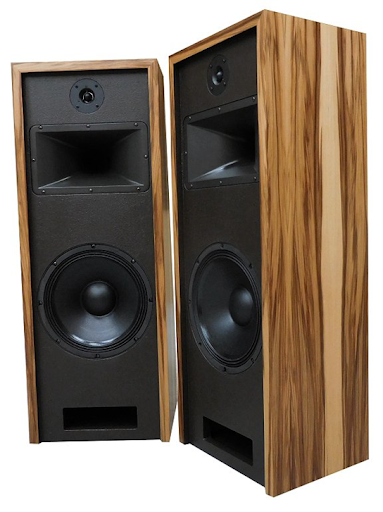
Why the Razz v.2?
You may have noticed that this review is for the Razz v.2. Here’s what Greg said when I asked him to explain what the v.2 changes were:
“Early on in production we ran into a supply issue on the tweeter and that’s what precipitated the change to a new tweeter. The crossover filters needed to be reworked for the new tweeter, and I took the opportunity to do some further refining of the woofer to midrange interface at the same time. The new tweeter has a larger diaphragm and wider dispersion lens, which on paper would tell you that it’s a better sounding tweeter than the original. But, the testing showed very little difference between the two, and I think both tweeters sound great. In the end, the sound of the v.2 Razz is slightly different from the original, and may in fact be slightly better than the original, but not enough that I think it is worth upgrading to.”
Crossover Design and Features
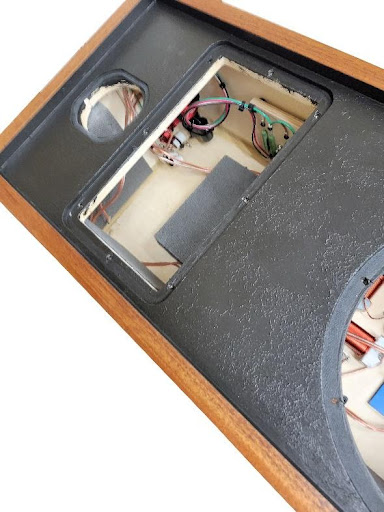
When discussing the crossover with Greg he told me that he “preferred the sound of gentle-slope crossovers to steeper slope, and I’m sure this is because gentle slope filters have fewer components. I’ve found that having fewer crossover components of higher quality results in a more natural sound and flow to the music. It’s about preserving the integrity of the signal and ‘doing no harm’. “
He went on to tell me…
“The Razz crossovers are split into three different boards. The lower filters are separate from the upper horn filters to reduce interference between the parts and the magnetic fields of the drivers. The third board, located next to the midrange horn and accessible by removing the horn, contains the resistors that are necessary to reduce the output of the more sensitive midrange and tweeter horns so they are properly balanced with the woofer. My customers can change resistors in order to change the balance of the midrange and tweeter if they choose.”
That’s a nice feature that gives you the ability to fine-tune the Razz to your system and room. To access the resistors, you can remove the large horn driver. Machine screws secure the drivers and not the usual wood screws a lot of manufactures use to save cost. I was pleased to see that!
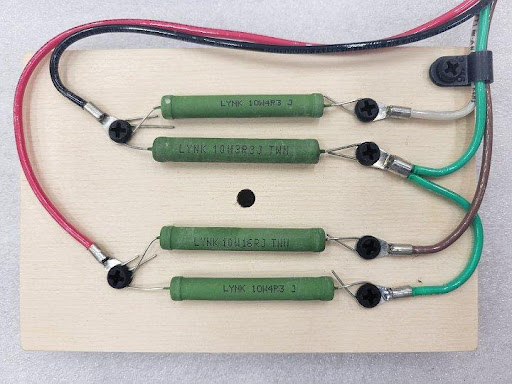
Additionally, the board under the resistors is removable to allow easy access for changing the resistors. Volti even uses a wing nut to secure the resistor board to make it easy to remove. These aren’t big things, but they indicate that Volti pays attention to the small details.
Speaker Placement

The Volti Audio Razz speakers arrived late one afternoon, and I was grateful that the delivery driver had a hand cart. The substantial double-boxing was impressive and designed to be reusable. The speakers were easy to unbox, and I soon had them running on the long wall of my 16 x 20 listening room.
After about 100 hours of break-in, I started the process of positioning the speakers. Of course, with any speaker, this is make or break for achieving optimum sound. I want to spend a little time with you on positioning because the Razz setup is not typical. Volti advises spreading the speakers wider than you normally would.
Finding the Optimum Width
Since my Acoustic Zen Crescendo IIs sit about 8 feet apart, I tried the Razz speakers the same distance apart. It was quickly obvious to me that they wanted a bit more room to stretch their legs and present a relaxed soundstage. At 8 feet apart the soundstage semed “bunched up”. I ultimately ended up with them about 12 feet apart tweeter to tweeter. That width threw a more relaxed soundstage that didn’t feel “forced” and allowed them to “play the room”. In my experience, you can’t spread many speakers this wide without creating a hole in the center, but the Razz speakers loved it.
Distance to the Rear Wall
Next, I set up the distance to the rear wall where I try to lock in the bass. The majority of speakers I review like to be 4 to 6 feet out from the rear wall in my room.
With the 12-foot-wide separation, each speaker’s distance to my side wall was 4 feet. Typically, you never want to be the same distance from the side and rear walls as it will excite a room node. So, I started at 3 feet and moved out from the rear wall. The Razz locked in at just under 6 feet out.
The bass was quite satisfactory in a variety of positions, but I stuck to it and found the optimum spot in the room to get the full reward. Once I landed on the spot, the bass locked in a vise and had a drive, speed, and tightness my Crescendo IIs could not match.
The Razz’s specified bandwidth is 35Hz-20K. It was true to spec when I measured it in my room, and the bass was was solid to 34Hz before dropping off quickly. I much prefer this approach rather than to have Volti add the “bass bump” you find in many speakers that try to fool you into thinking the speaker has more bass than it does. I’ll take bass quality that is clean, fast, tight, and has good definition any day. The Razz delivers in that area!
Speaker Toe-in
With the bass locked in, the next item up was speaker toe-in. For the vast majority of speakers I have tried in my room, the toe-in angle ends up being just behind my head.
I began with the Razz pointing directly at my seating position. Listening to a song, I moved my head back and forth to determine the best toe-in angle. When doing this, there is usually a point where you feel like you have just stuck your head through a window and into the venue. That is what I listen for. If you are too far back, you may feel like you are looking through a framed window. If you are too far forward, you get that Left-Right-Center feeling. Having the speaker point to just in front of my head was the best position.
However, I will add that on a few recordings, having them point right at me was my preferred sound. In those cases, I would simply lean forward a bit to listen to that particular cut. Like most speakers, changing the toe-in also has an impact on the bass. Be aware of this as you tune any loudspeaker to your room.
Vertical and Horizontal Dispersion
I am going to add a quick note here about vertical and horizontal dispersion. When I sit in my listening chair, my ear height is normally 42 inches. Listening to the Razz, I wanted to slide down just a bit to hit what I thought was the best integration of drivers. That spot meant my ear height was 38 inches, a very common ear height for most people. I suspect it is not a coincidence that this is also the height of the Razz tweeter. Since I am 6’4”, I sit a bit higher, and I noticed a very slight shift in tonal balance.
Just be aware of this with any horn loudspeaker if you sit in an unusually high or low chair when you listen. The horizontal dispersion was very good with the money spot still being dead center. Moving one space to the left or right of the sweet still offered a very nicely balanced sound. So this is not a “head in the vise” type of loudspeaker.
Hooking Up the Razz Speakers
On the digital side, I used the PS Audio PST CD/SACD transport, Soundaware D300REF digital transport, and my Denafrips Terminator Plus DAC as sources. On the analog side, I used my AMG Viella 12JT/ DS Audio Master One combo. These sources fed my Denafrips Athena preamp. Triode Labs Wire and Audience were used for the cabling. Three different amps were used, the PS Audio M1200s, a First Watt SIT-3, and a Quicksilver MX 190 using the 8 ohms tap.
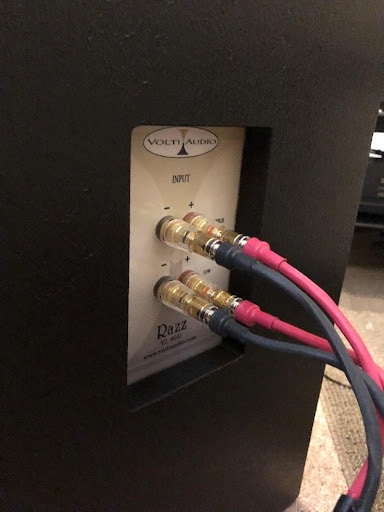
The PS Audio amps were a lot of fun and they produced by far the most dynamic presentation. But as good as the PS Audio amps are on my Crescendo IIs, the Razz demanded something with more organic density.
The Quicksilver amp had everything you would expect from a 6CA7-based amp. It had a golden midrange and a rich tonal balance with a more three-dimensional outline of instruments and vocals. However, it did not offer the transient speed or the inner detail and bass definition/drive that I was looking for.
For me, the “Goldilocks” amp was the First Watt SIT-3 offering up the inner detail and openness I was looking for with very good dynamics. Its tonal balance and midrange density leaned more toward the Quicksilver amp than to the PS Audio amp. I talk a lot about system synergy, and this was a great example. All three amps are quite good but there was one clear winner in this case.
Greg prefers a bi-wire configuration and told me that in his testing he could “… clearly hear the difference with the bi-wire. Music was tighter and better defined in the bass, and clearer through the midrange.” I compared bi-wire and single-wire configurations, and while I would give the edge to bi-wire, it was not a large difference.
Prejudging
Here’s a word of advice. Just because these speakers use a horn design, do not think you already know how they are going to sound. I was completely blindsided by the Razz. This is not your Klipsch horn sound of yesteryear that many people have been exposed to. This is a horn loudspeaker that does not sound like one. In the Razz, like their more expensive speakers, Volti Audio has managed to harness the advantages of a horn driver, such as excellent dynamics and low distortion, and alleviate many of the problems.
The Razz does not have the typical flaws I associate with horns like edginess, poor integration of drivers, and that “shouty horn” sound. Just for grins, I had two seasoned local listeners come by and audition the Razz with the grill covers on. When I asked them what type of drivers they thought were used in the Razz, neither of them thought they were horn-based loudspeakers. Nope, this is not your father’s horn loudspeaker.
The Razz Sound
Have you ever been to a small acoustic concert and put on your audiophile hat? Have you ever closed your eyes and tried to imagine you were hearing it in your listening room on your system? Of course, you have!
Typically, the venue, like your room, has less than perfect acoustics. Perhaps the acoustic bass is slow and ill-defined, or the piano sounds muffled, or the drummer is simply walking over everyone in the band. Despite that, you enjoy the music. The instruments sound “right” even if the venue is acoustically poor or the instruments are poorly set up. You listen through the problems and still enjoy the music.
This is much like vinyl listeners who talk about groove noise being “part of the music” or “separate from the music”. So it is with the Razz, as they offer an “immediacy” that delivers a touch of reality. They allowed me to listen through the medium to the music and be attracted to the music itself.
The articulation is excellent. I had an easier time than usual understanding the lyrics. The Razz seemed to resolve complex passages more easily. I think this clarity is a result of the midrange’s ability to delineate the leading and trailing edges of transients. The resolution of low-level detail in the midrange gives it a wide-open quality that is very transparent and feels effortless. It integrates with the rest of the music to deliver that “sing with one voice” quality. I could not detect the midrange to tweeter transition. You would swear this is a two-way loudspeaker.
Are They Perfect?
The Volti Audio Razz v2s aren’t perfect, or are they? Of course not. During my listening, there were moments where I thought a bit lower bass extension would be nice, but then again, 35Hz is very good bass extension for a speaker of the size, high-sensitivity and price point of the Razz. Depending on your personal preference, you may want to have the midrange moved forward just a touch and a bit more “air” and transparency to the presentation.
The beauty of the Razz v2s is that you can do that by changing the crossover resistors I spoke of earlier. The resistors impact the output of the midrange and the tweeter. For instance, if the Quicksilver amp was the only amp I owned, I would want to raise that output level a touch. On the other hand, with the First Watt SIT-3 in place, the stock resistors proved to be just fine. There are not a lot of loudspeakers on the market that let you “fine tune” their sound to synergize with your system. I consider that to be of tremendous value.
Graceland, Paul Simon
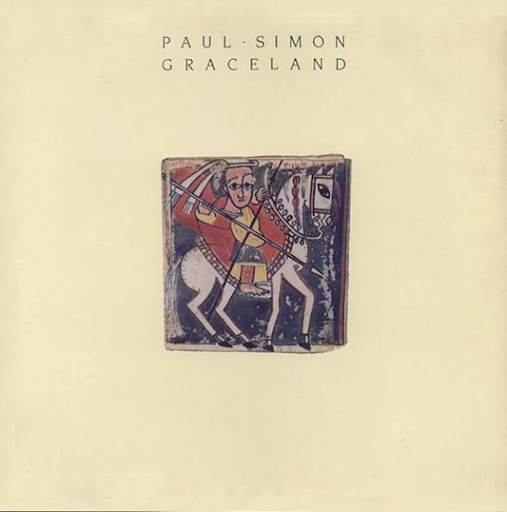
Every time I go back and listen to this album, the variety of artists and the pure artistry of the music amazes me. If you are not aware of the background of this 1986 album, invest a little time to watch the interesting “Under African Skies” documentary. Here is a link to the trailer: https://www.paulsimon.com/video/under-african-skies-graceland-documentary-trailer/. I bet you’ll learn something you didn’t know. I know I did.
When I dropped the needle on the “Homeless” cut, it sounded like the Ladysmith Black Mambazo group was spread out across my room, wall to wall, with each singer in their own space. Listening to “I Know What I Know,” The Gaza Sisters were in full relief with stand out harmonies. Many speakers render them as less significant contributors to the song. The Razz loudspeakers let me fully understand what they brought to the music. When listening to the drum work and bass line on “You Can Call Me Al,” I was aurally and physically coupled to the music. I had a lot of fun listening to the entire album.
Soundstage… Proper Scaling
Here the Razz speakers excel…so much so that I want to devote a special section to it. Simply said, the Razz v2s threw the most complete, immersive, and realistic soundstage I have experienced in my listening room to date. Every “live” album I put on, immediately drew me into the venue. What was interesting is that the Razz managed to recreate the venue to the proper scale. It rendered a smaller jazz club I visited to that scale, a recording in a church had that sense of room size, and it recreated a large-scale concert with that “feel”. This is a very impressive accomplishment that is not easily done. Many times the speaker will jam everything into a similar-sized soundstage. Not so with the Razz. It is a soundstage chameleon that morphs into the scale of the recording.
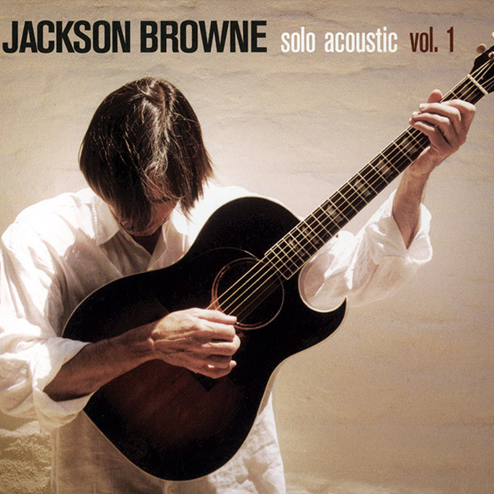
With that in mind, there was one album/experience that needs a special callout. On March 17, 2008, I saw Jackson Browne perform almost this exact concert live at the Saenger Theater in Mobile AL. After the concert, I visited backstage with him. I think he is one of the most gifted songwriters of our time.
As soon as I fired up this disc on the Razz it transported me back to that night. In the first 30 seconds of audience chatter and hall ambiance, before Jackson comes on stage, I could already tell I was in for something special. The recreation of the applause, the whistling, and the yelling that came through on the Razz was frankly quite disarming. Jackson’s guitar work and the piano sounded right both dynamically and tonally. His vocals were wide open with nothing between me and them. It was quite special to hear.
The exceptionally large soundstage thrown by the Razz loudspeakers recreated the venue as I remembered it from that night. The bottom line is I haven’t had a speaker in my room take me back to that night in 2008 more intensely and intimately than the Volti Razz. In this case, the Razz was a time machine for me.
“Wildly Civilized”
If you have stayed with me this far, by now you can tell that I really enjoyed my time with the Razz loudspeakers. I wish it could have been longer. Three months pass fast when you are having fun. I already miss the “life” and the smiles they brought to my listening sessions.
If you have read other Volti Audio Razz reviews, you will note a common thread from reviewers commenting on the “fun factor” these speakers bring to one’s system. While that is certainly true, the Razz also brings a touch of “real” into your listening room. In the end, I found that it was the overall “rightness” of the sound that captured my attention. This rightness provided the many hours of listening pleasure I enjoyed during their time in my room.
The other night I was watching the latest drops of my newest Mini-Drama addiction, Only Murders in the Building and 9 Perfect Strangers, when a Jeep Grand Cherokee commercial appeared. It showed a beautifully appointed leather interior Jeep Cherokee traversing off-road trails, fording streams, towing boats, and generally just having fun. What caught my attention was the tagline when they called the Jeep Grand Cherokee “Wildly Civilized”.
I immediately thought of my time with the Razz. I am not sure I could come up with a better description. The Razz loudspeakers strapped me in and took me on a “Wildly Civilized” audio trip. In the end, it delivered me to my destination in style and with a smile on my face.
If you have a chance, I suggest you take a ride with the Volti Audio Razz speakers. You may end up visiting some “audio terrain” other speakers haven’t been able to take you to.
Highly recommended for your consideration.
Priced: $5,900 pair in standard finishes, optional finishes available at an upcharge

Hi could you review the new Stage Accompany Master M57 or M59 speakers with bamboo cabinets ? Some of the very best speakers ever made period but nobody wants to review them. Many Musicians use these speakers now !
Thank You
Greetings Rick,
Those look like some excellent studio monitors. As I read about them, I see that in-wall flush mount the recommended installation which would make them quite hard to review.
My wife is VERY understanding but…… Hah!
I will touch base with them and see if they are interested in a review with them used in a free standing environment.
Thanks for bringing them to my attention. -ken